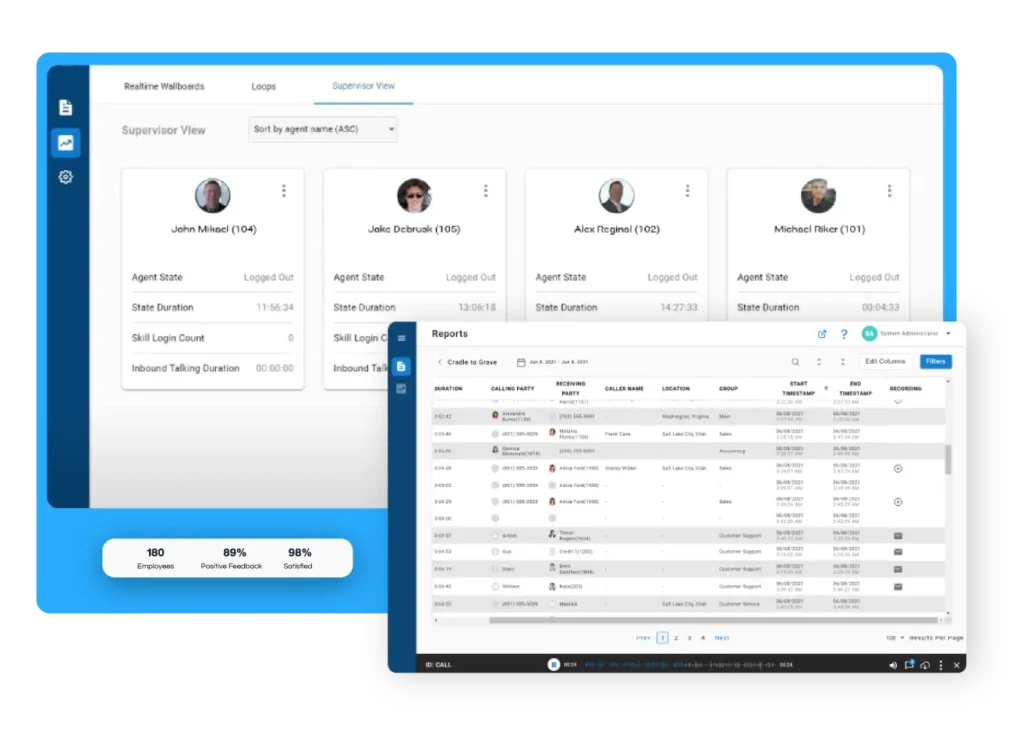Customer satisfaction isn’t just a feel-good metric—it’s the lifeblood of long-term business success. In today’s experience-driven world, companies that consistently deliver satisfaction build stronger relationships, earn repeat business, and fuel sustainable growth. That’s where CSAT, or Customer Satisfaction Score, comes in. It’s a straightforward yet powerful tool that helps businesses gauge how well they’re meeting customer expectations in real time.
From evaluating specific interactions to informing big-picture customer experience (CX) strategies, CSAT offers actionable insights that can shape everything from support training to product development. Let’s dive into what CSAT is, how it works, and how to measure it effectively.
What is CSAT (Customer satisfaction score)?
If you’re wondering what CSAT is. It’s short for Customer Satisfaction Score, a key metric that measures how satisfied a customer is with a specific interaction, product, or service. Typically gathered through quick post-interaction surveys, CSAT captures the customer’s immediate reaction—making it one of the most direct ways to understand how they feel about their experience.
Whether it’s a support call, a product purchase, or a delivery experience, CSAT surveys ask customers to rate their satisfaction, usually on a scale from 1 to 5 or 1 to 10. The simplicity and immediacy of CSAT make it a go-to metric for businesses looking to assess performance at the moment and act quickly on feedback.
How do you measure CSAT?
CSAT is measured by asking customers to rate their satisfaction after a specific interaction, product use, or service experience. The most common way to collect this feedback? A simple survey. These short, targeted surveys usually ask a question like, “How satisfied were you with your experience?” and offer a rating scale–often 1 to 5 or 1 to 10. You might be wondering how to measure CSAT. If so, keep reading to learn about the different ways to deliver CSAT surveys, and the method you choose can influence response rates and data quality:
- Post interaction surveys: Often delivered immediately after a customer support chat or call, these real-time prompts catch customers while the experience is fresh in their minds.
- Email surveys: Sent after a purchase or service interaction, email surveys are a reliable way to gather feedback, especially if you want to add an optional comments section.
- In-app surveys: Perfect for SaaS platforms or mobile apps, these surveys appear directly within the product experience, making it easy for users to respond without leaving the interface.
Regardless of the delivery method, consistency is key. Using a uniform rating scale across all survey touchpoints ensures that your CSAT data remains clean, comparable, and easy to analyze over time. With a steady stream of feedback, businesses can track trends, identify friction points, and make data-driven improvements to elevate the customer experience.
Calculating your CSAT Score
Once you’ve collected customer responses, calculating your CSAT score is refreshingly simple. The standard formula focuses on the percentage of customers who reported being satisfied–typically those who select the highest options on your survey scale.
Here’s the formula:
CSAT (5)= (Number of satisfied customers/Number of total responses) X 100
Let’s say you’re using a 5-point scale, where 4= “Satisfied” and 5= “Very Satisfied.” If 80 out of 100 respondents choose 4 or 5, your CSAT score would be:
(80/100) X 100 = 80%
Most businesses consider scores of 4 or 5 on a 5-point scale (or 8, 9, and 10 on a 10-point scale) as indicators of satisfaction. Here’s how those scores typically translate:
Rating (5-point scale) | Customer Sentiment |
5 | Very Satisfied |
4 | Satisfied |
3 | Neutral |
2 | Dissatisfied |
1 | Very Dissatisfied |
Your Target CSAT score may vary depending on industry benchmarks, but generally, a score above 75% is considered strong. The real power lies in tracking your CSAT over time–watching how its trends can reveal how customer satisfaction rises or dips in response to new initiates, politics, or service changes.
Why is measuring CSAT important for contact centers?
In the fast-paced world of customer service, every interaction counts—and CSAT provides a clear window into how those interactions are landing. For contact centers, measuring CSAT isn’t just about checking a box. It’s about understanding what’s working, what’s not, and how each customer touchpoint contributes to long-term business success.
High CSAT scores are often directly linked to increased customer loyalty and retention. When customers consistently walk away from support interactions feeling satisfied, they’re more likely to stay loyal to your brand, recommend your services, and spend more over time. On the flip side, consistently low CSAT scores can signal unresolved pain points that drive customers straight to the competition.
By tracking CSAT regularly, contact centers can:
- Identify areas for improvement: Spot patterns in low scores to uncover friction points in your customer journey—whether that’s long wait times, unhelpful responses, or unclear resolutions.
- Understand customer sentiment: Beyond raw numbers, CSAT reveals how customers feel about your brand, giving you valuable context that’s often missing from operational metrics alone.
- Track performance over time: Consistent measurement makes it easier to assess how changes—like updated scripts, new tools, or staffing adjustments—impact satisfaction.
When leveraged effectively, CSAT becomes a key driver for improving contact center performance. Managers can use this data to provide targeted coaching, recognize high-performing agents, and make smarter decisions about workflows and resource allocation. For a deeper look at how reporting and analytics empower better business decisions, check out why contact center reporting is crucial for business success.
Best Practices for Improving CSAT
Improving your CSAT score starts with designing smart feedback strategies and delivering better service experiences. These best practices can help you boost satisfaction across your contact center operations.
Ask the Right Questions at the Right Time
CSAT surveys should be short, specific, and sent immediately after an interaction while the experience is still fresh. This increases the chances of getting honest, useful feedback that reflects the true quality of service.
With Xima’s multi-channel communications, you can send surveys through the customer’s preferred channel–whether that’s SMS, email, or in-app–maximizing reach and response rates.
Keep it simple and focused.
Limit questions to what matters most—usually one core satisfaction question followed by an optional open-ended comment box. Shorter surveys reduce friction and encourage higher response rates.
Use a consistent rating scale.
A 1–5 or 1–10 scale is most common. Stick with the same format across surveys to make it easier to track performance over time. With Xima’s reporting and analytics, you can monitor scores in real-time and spot trends that help you fine-tune your service.
Send surveys at the right time.
Timing is everything. Sending surveys immediately after an interaction ensures feedback is accurate and relevant. Xima’s skill-based routing also plays a role here—by connecting customers to the most qualified agents, you increase the chances of a positive experience before the survey even goes out.
Take action on feedback.
Feedback without follow-through is a missed opportunity. Use Xima’s live agent call recording to review interactions, identify coaching opportunities, and address recurring issues. When you show customers that their input leads to real change, satisfaction naturally improves.
With the right strategy and tools, CSAT surveys can become a powerful engine for continuous improvement and customer loyalty.
Start Improving Your CSAT Today with Xima
Customer satisfaction isn’t just a feel-good metric–it’s a direct line to better loyalty, stronger retention, and long-term business success. Measuring CSAT gives you insight into the customer experience, calculating CSAT helps you quantify performance, improving CSAT empowers your team to deliver more meaningful interactions.
Xima makes it easy to turn insights into action with enterprise-grade features designed for growing businesses. Whether you’re fine-tuning agent performance, analyzing trends, or optimizing service delivery, Xima gives you the tools to elevate every customer interaction.
Ready to see the impact for yourself? Try a demo today and explore how Xima can help you improve your CSAT—and your customer experience from day one.
FAQs about CSAT
While CSAT measures satisfaction with a specific interaction, Net Promoter Score (NPS) gauges overall brand loyalty by asking how likely a customer is to recommend your business. Customer Effort Score (CES) measures how easy it was for customers to complete a task or resolve an issue. Each serves a different purpose, but CSAT is especially useful for assessing real-time service quality.
A good CSAT score generally falls between 75%-85%, though this can vary by industry. The key is consistency–measure CSAT regularly after customer interactions to spot trends and respond to changes in customer sentiment quickly.
Keep the survey simple but targeted. You can customize follow-up questions based on interaction type, channel, or customer segment to uncover deeper insights. Using tools like Xima’s multi-channel communications, you can also deliver surveys in the format your customers prefer.
Avoid sending too late, using overly complex scales, or failing to act on feedback. These missteps can lead to response rates and missed opportunities for improvement. Stay proactive, keep surveys concise, and follow up with changes based on what your customers share.
Get Your Free Demo Today
Get updates and learn from the best
More To Explore
Call Center Speech Analytics with Historical Transcription: A Must-Have for Your Business
Every customer conversation holds invaluable insights, but only if you know how to uncover them.
5 Benefits of AI in IVR for Businesses
Picture this: a customer calls your business, and instead of waiting through endless menus or long hold times, they’re instantly greeted by an intelligent system that understands their needs. That’s the power of AI-driven Interactive Voice Response (IVR).





